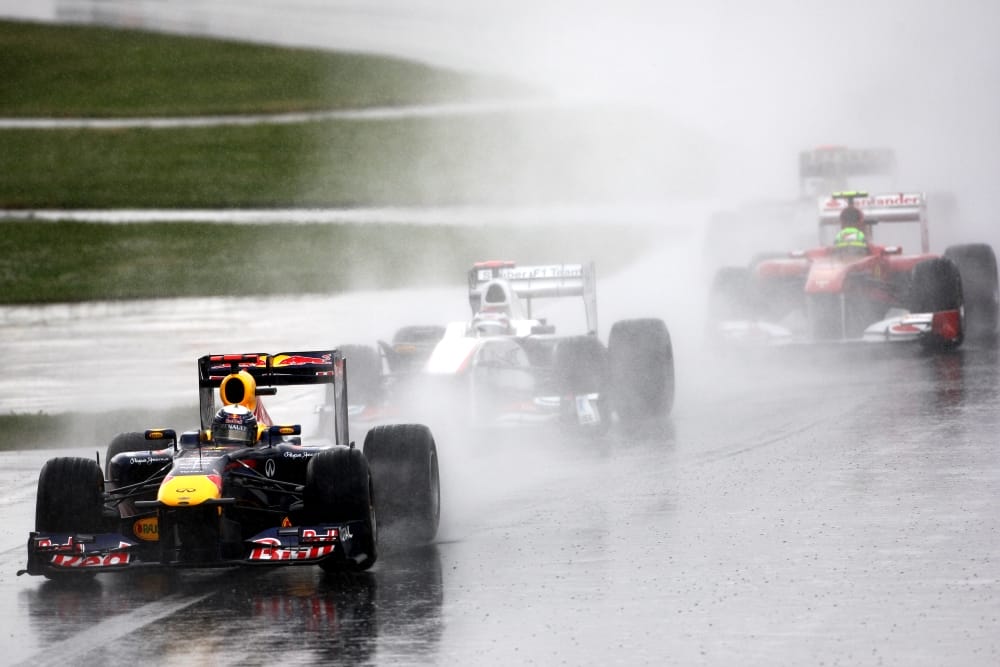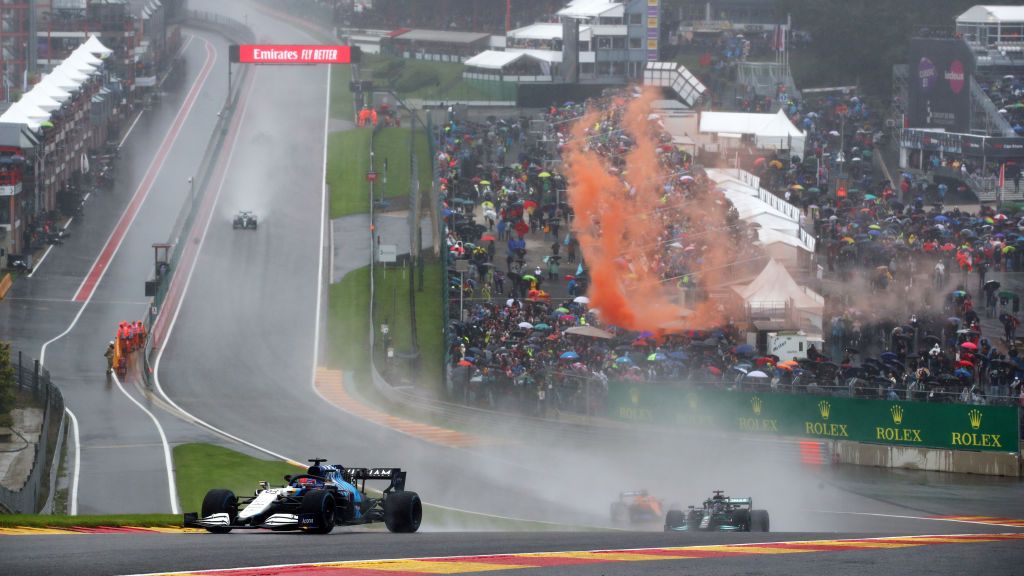When the Rain Falls: Formula 1’s Most Legendary Wet Weather Races
In Formula 1, rain doesn’t just dampen the track—it transforms the entire character of a race. In the dry, the sport is a precise calculation of engineering, pace, and strategy. The fastest cars usually remain at the front, while championship contenders execute carefully crafted race plans with relative predictability.
But in the wet, all of that order evaporates. Grip levels change corner by corner. The usual racing line might no longer be the fastest route. Visibility becomes a battle in itself as drivers peer through walls of spray. And in the most extreme conditions, even world champions are reduced to survival mode.
Over the decades, some rain-soaked Grands Prix have become the stuff of legend. They’re remembered not just for who won, but for the chaos, the brilliance, and the resilience that the conditions demanded. From career-defining drives to championship-altering decisions, wet weather has often written the most dramatic chapters in Formula 1 history.
Let’s revisit some of the most unforgettable moments.

1976 Japanese Grand Prix – Hunt vs. Lauda in a Storm
Few seasons in Formula 1 history have been as dramatic as 1976. The rivalry between James Hunt and Niki Lauda had already swung through triumph, tragedy, and comeback long before the final round at Fuji Speedway. Lauda had miraculously returned to racing just six weeks after suffering horrific burns at the Nürburgring, and the championship came down to one final race.
But on the morning of Japan’s first Grand Prix, torrential rain drenched the circuit. Standing water pooled across the track, and visibility was almost nonexistent. The cars of the era had limited downforce and primitive wet-weather tires, making aquaplaning a constant threat.
After just two laps, Lauda—still dealing with the aftereffects of his injuries and unable to blink properly in the spray—made the brave decision to retire, deciding that the risk wasn’t worth it. Hunt pressed on, knowing he needed third place to clinch the title. A late puncture threatened to derail his hopes, but he clawed his way back to third and sealed the championship by a single point.
It wasn’t a race of close battles, but rather of survival, psychology, and courage. Lauda’s withdrawal and Hunt’s gritty recovery ensured Fuji would be remembered forever.
1984 Monaco Grand Prix – Senna Arrives
If Fuji in 1976 was about caution, Monaco in 1984 was about revelation. A torrential downpour turned the narrow streets of Monte Carlo into a skating rink. At the front, Alain Prost controlled the pace in his McLaren, while behind him, a young Ayrton Senna was making history.
Driving for the unfancied Toleman team, Senna started 13th but cut through the field with breathtaking confidence. Finding grip in impossible places, he closed on Prost at a remarkable rate, reducing the gap by seconds per lap. By lap 31, he was on Prost’s tail, ready to challenge for the lead.
Just then, race officials stopped the race due to worsening weather. Prost was declared the winner, with Senna second. It wasn’t a victory, but it was a statement: Senna had arrived, and the world had witnessed a masterclass in wet-weather driving.

1993 European Grand Prix – Donington’s Lap of the Gods
If Monaco ’84 announced Senna’s talent, Donington Park in 1993 cemented his legend. The race began on a damp track, and Senna’s McLaren was outclassed on paper by the dominant Williams-Renaults of Prost and Damon Hill.
A poor getaway dropped Senna to fifth, but what followed has been immortalized as the greatest opening lap in Formula 1 history. In a single tour of Donington, he overtook Michael Schumacher, Karl Wendlinger, Hill, and finally Prost, taking the lead with audacious moves and uncanny grip.
The weather remained changeable throughout, forcing multiple tire stops. While others faltered with timing, Senna seemed perfectly in sync with the conditions, building a lead of over a minute. His win was emphatic, but it was that opening lap—a symphony of instinct, precision, and courage—that ensured its place in racing folklore.
2003 Brazilian Grand Prix – Chaos at Interlagos
If Senna’s drives were about brilliance, Interlagos 2003 was about chaos. Torrential rain before the start left the track soaked, but unevenly—some corners were nearly dry, while Turn 3 became a notorious trap for aquaplaning.
One by one, drivers slid into the barriers. Safety cars repeatedly neutralized the race as incidents piled up. Local hero Rubens Barrichello briefly looked on course for a fairytale win before his Ferrari ran out of fuel. In the mayhem, Giancarlo Fisichella snatched the lead for Jordan.
When a massive crash involving Mark Webber and Fernando Alonso brought the race to a premature end, a timing error initially declared Kimi Räikkönen the winner. Only days later did the FIA correct the result, giving Fisichella his first victory. The Brazilian Grand Prix of 2003 was less about mastery and more about sheer survival—and the cruel unpredictability of the rain.
2008 British Grand Prix – Hamilton’s Masterclass
Silverstone in 2008 gave Lewis Hamilton one of his most iconic victories. Starting fourth in pouring rain, Hamilton immediately surged into contention, but the real story was his pace in conditions that humbled his rivals.
While championship contenders Felipe Massa and Räikkönen spun multiple times, Hamilton was almost untouchable. His lap times were often seconds faster than the rest of the field, his car seemingly glued to the soaked tarmac while others slid helplessly.
By the flag, Hamilton had lapped all but two cars and won by over a minute—a margin virtually unheard of in modern F1. The drive reignited his championship campaign and confirmed his reputation as one of the sport’s greatest wet-weather specialists.

2011 Canadian Grand Prix – The Four-Hour Marathon
The Canadian Grand Prix of 2011 remains the longest race in F1 history, stretching to over four hours. Heavy rain caused multiple stoppages, including a two-hour red flag for standing water. For Jenson Button, the day began disastrously—collisions, a penalty, and even running last.
But as the race wore on and conditions evolved, Button produced a comeback for the ages. He made perfectly timed tire changes, carved through the field, and on the final lap pressured Sebastian Vettel into a rare mistake. From last place to first, Button’s victory was one of the most dramatic turnarounds in the sport’s history, made possible only by the chaos of the rain.
2020 Turkish Grand Prix – Hamilton Seals a Seventh Title
When Formula 1 returned to Istanbul Park in 2020, the freshly resurfaced track was already slippery. Add a steady rain, and conditions became treacherous even by F1 standards. Cars struggled for grip everywhere, spinning on straights as if on ice.
Lance Stroll led early on, but as the track slowly dried, tire management became crucial. Hamilton, starting sixth, extended his intermediates long enough for them to morph into slicks as the surface improved. While rivals floundered, Hamilton’s judgment and composure carried him into the lead.
He won by over 30 seconds, securing his seventh world championship in style. It wasn’t the flashiest wet-weather win, but it was a masterclass in patience and precision.
The Legacy of Rain in Formula 1
Wet-weather Grands Prix are a reminder that Formula 1 is not just about machinery and raw pace. They reward adaptability, intuition, and resilience. They give underdogs a chance and force champions to dig deeper than ever.
From Fuji in 1976, where Lauda made a life-defining choice, to Senna’s genius at Donington, to Hamilton’s Silverstone dominance and Button’s last-lap miracle in Montreal, these races endure because they reveal something fundamental: when the rain falls, the stopwatch doesn’t tell the full story.
Formula 1’s wet-weather epics show us drivers at their most human and their most heroic. They’re proof that sometimes, the greatest drama comes not from the perfect plan, but from the storm that disrupts it.
News
Die Welt hat sich weitergedreht: Marie Fredriksson rechnet leise ab – 5 Stars, die sie im Stich ließen.
Der Klang von Roxette war der Soundtrack einer ganzen Generation. Mit Hits wie „It Must Have Been Love“ und „The…
Conny Froboess: Die bittere Wahrheit hinter der Traumkarriere – Im Alter trägt sie eine unheilbare Wunde.
Der Name Conny Froboess ist in Deutschland untrennbar mit einem Gefühl von Leichtigkeit und sonnigen Kindertagen verbunden. Wenn ihr größter…
DER WACKELDACKEL DER REPUBLIK: WIE MERZ’ „HERBST DER REFORMEN“ IN EINER EISZEIT DER STARRE ENDETE UND UNSERE ZUKUNFT VERPFÄNDET WIRD
Einbruch in die politische Wirklichkeit: Die bittere Bilanz nach dem Versprechen des Aufbruchs Mit großen Versprechungen begann die Zeit, die…
Bommes’ Nerven liegen blank: Unerwarteter Eklat in der letzten Folge von „Gefragt – Gejagt“ schockt die Fans
Ein Augenblick, der das harmonische Ende einer Quiz-Saison sprengte. Ausgerechnet in der vorerst letzten Ausgabe der erfolgreichen ARD-Show „Gefragt –…
Herzschlag-Finale in der Scheune: Friedrich und Laura trotzen dem TV-Kitsch mit dem ehrlichsten Liebesbeweis der Staffel
Der leise Moment, der lauter spricht als jede große Inszenierung Es war der Moment, auf den Millionen von Zuschauern der…
Kai Pflaume bricht sein Schweigen: Das 30-Jahre-Geheimnis hinter Deutschlands Vorzeige-Ehe und warum seine Ilke sein wichtigstes Korrektiv ist
Die deutsche Fernsehlandschaft hat viele Gesichter, aber nur wenige sind so konstant, so sympathisch und so untrennbar mit dem Gefühl…
End of content
No more pages to load












